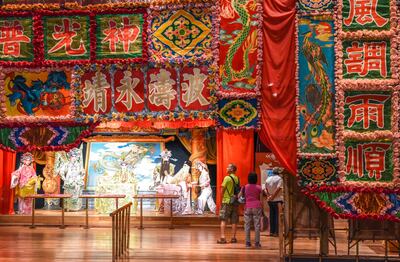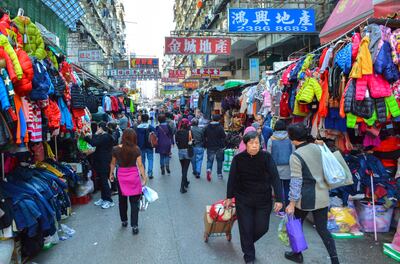Hong Kong is finally open to tourists again, following more than two years of pandemic-related restrictions. Visitors flying into the territory no longer have to quarantine in a hotel and are only required to test negative for Covid-19 upon arrival.
Hong Kong was the world’s most-visited city in 2019, according to market researchers Euromonitor International, thanks to its many well-known attractions including Victoria Harbour, Victoria Peak, Hong Kong Disneyland and Lan Kwai Fong entertainment precinct.
However, beyond these tourist hotspots lies a wealth of fascinating yet comparatively ignored sites. Here are five of the best.
Cattle Depot Artist Village

Bypass the famous Hong Kong Arts Centre in favour of a formerly depressing building that's become one of the city's most distinctive cultural facilities, the Cattle Depot Artist Village. Dating back to 1908, this large complex was a slaughterhouse before it was reborn in 2001 as an eclectic community of creatives.
Tourists are welcome to wander the village, which has rotating exhibitions that range from paintings to sculptures, art installations and multimedia displays. There are also murals sprayed across the walls throughout.
More than 20 artists are based here and some allow visitors to see inside their studios — simply ask at the village reception to find out what spaces you can enter that day. If you’re lucky, the Frog King may be home. This quirky performance artist, whose real name is Kwok Mang Ho, is a master of calligraphy, street art and installations. But he’s best known for his unmistakable appearance — a bizarre, black-and-white frog costume that he wears regularly.
Kowloon Walled City Park

Avoid the bustling Hong Kong Park and instead enjoy the comparative peace of Kowloon Walled City Park, which has a surprisingly chaotic backstory. Walking through this serene green lung, about 2km east of the popular tourist district of Mongkok, it is hard to believe it was once one of the most lawless places in Hong Kong history.
While wandering its beautifully-landscaped gardens, I come across a scaled model of the colossal housing complex that existed here until 1994. It was called the City of Darkness and up to 30,000 people lived in these connected, decrepit apartment towers, which formed one of the most densely populated locations on the planet.
It was crowded, run down and almost a no-go zone for police. The City of Darkness was commanded by the ultra-powerful Chinese Triads gang and crammed with illegal businesses and activity.
Hong Kong Heritage Museum

Instead of visiting the often-crowded Hong Kong Museum of History, head to the comparatively quiet Hong Kong Heritage Museum, which details the artistic and cultural history of the city. Located north of the city centre, in Sha Tin, this museum makes for a great day trip when combined with the nearby Ten Thousand Buddhas Monastery and Che Kung Temple, a commanding and photogenic Taoist complex.
This huge, modern museum has a dozen galleries, home to six permanent exhibitions that focus on Chinese ceramics, martial arts, Hong Kong pop culture, the delicate paintings of China’s Lingnan School, the vibrant costumes of the Cantonese opera and children’s education. From now until late February, visitors can also appreciate the brilliant textiles and embroidery of female artists at a new exhibition called Women and Femininity in Ancient China.
Ten Thousand Buddhas Monastery

Forget Kowloon's busy Wong Tai Sing Temple and head further north to climb a hill to the Ten Thousand Buddhas Monastery, which takes its name from the number of statues that line its stairs. I can’t quite understand why this unusual temple isn’t better promoted, particularly in an age of social media-influenced travel.
The monastery is easily reached, located next to Sha Tin MTR station, about 9km north of tourist hotspot Tsim Sha Tsui. Yet, it is so far off the city’s tourist trail that to access it, I have to wander behind a weathered apartment block and pass through a rusty old gate.
Then I see a rickety sign warning: "Do not give money to fake monks seeking alms [handouts]." During my long ascent up the hill, I encounter no such fraudulent holy men. However, I do become entranced by the thousands of golden Buddhas, each of which has a different posture or expression.
Some are pensive, others jovial, stern or furious. Some hold weapons, others clasp books, animals or alms bowls. Beyond them, at the crest of the staircase, is a colourful Buddhist temple built in the 1850s, surrounded by lush forest. It is an attractive complex, although the real highlight here is that long line of monk statues.
Sham Shui Po markets

Ignore the touristy Mongkok Ladies Market, which overflows with fake designer goods, and instead shop with the locals at Sham Shui Po markets. Located two MTR stops north of Mongkok, Sham Shui Po is laden with street markets, each one different.
Hong Kong is a popular place to buy electronics for many, and Apliu Street is lined with both electrical stores selling the latest gadgets and street stalls offering phone and laptop accessories. For Children,, Hong Kong’s famous bazaar on Toy Street is nearby. Finish up at Pei Ho Street, one of the best food markets in the city, with delicious, freshly-cooked comfort foods.












